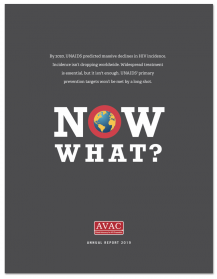Today, AVAC released Now What?, our 2019 annual report on the state of the HIV prevention field. Each year, the AVAC Report frames the most pressing advocacy issues facing the HIV response. At the threshold of 2020, it’s clear that global goals for HIV prevention will miss the mark by a long shot.
Though important progress has been made, the crisis UNAIDS called out in 2016 persists today with new infections around 1.7 million annually, a far cry from the 2020 target of fewer than 500,000.
So, we asked ourselves, Now What?, and answered with cross-cutting analysis and an advocacy agenda to match.
- Visit the Now What? website
- Download AVAC Report 2019: Now What?
- Download infographics from the Report
FIRST, we call for leadership that is bold, visible and activist, from the new head of UNAIDS, to houses of parliament to civil society coalitions: take uncompromising stances, demand accountability, speak out for intersectional issues of race, gender, class and climate. This work needs to be funded, full-throttle and fearless.
SECOND, we call for the use of today’s most recent evidence to guide new prevention targets that will pave the way for epidemic control. Clear milestones for the prevention research pipeline must be set. Investments over the past decades have provided us with the prevention options we have today, and much-needed new strategies are under now investigation. The field needs targets for prevention research that people can understand and influence.
THIRD, we call for multilayered prevention approaches that are centered around the person, not the virus. Since last World AIDS Day, we’ve learned again, perhaps most strikingly from the ECHO trial, about the dynamic needs of women for HIV and pregnancy prevention. The complexity of translating results into policy, bring renewed urgency to the need for comprehensive HIV prevention and reproductive health approaches. Multilayered prevention incorporates multipurpose strategies (i.e., products that prevent both pregnancy and HIV) within programs designed to address structural barriers (i.e., policy reform, transforming community norms, facilitating educational empowerment).
2020 will be a pivotal year—join us in calling on leaders, from the grassroots to global capitals, to make 2020 a turning point, when siloes come down, crises are transformed by innovation, and prevention is center stage in the fight against HIV.
Happy reading, and we’d love to hear how you answer Now What?
